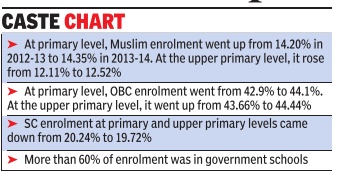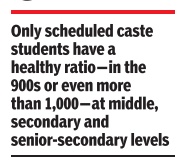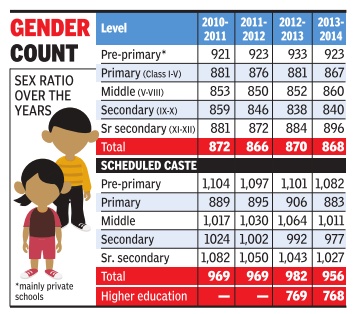Education: India
(→See Also) |
(→See also) |
||
| Line 154: | Line 154: | ||
=See also= | =See also= | ||
| − | |||
[[Education: India ]] (covers issues common to all categories of Education) <> | [[Education: India ]] (covers issues common to all categories of Education) <> | ||
[[Engineering education: India ]] <> | [[Engineering education: India ]] <> | ||
| Line 161: | Line 160: | ||
[[Primary Education: India ]] <> | [[Primary Education: India ]] <> | ||
[[School education: India ]] (covers issues common to Primary and Secondary Education) <> | [[School education: India ]] (covers issues common to Primary and Secondary Education) <> | ||
| − | [[Secondary Education: India ]] | + | [[Secondary Education: India ]] <> |
| + | [[Indian universities: global ranking ]] …and many more. | ||
Revision as of 16:59, 14 January 2015
This article has been sourced from an authoritative, official readers who wish to update or add further details can do so on a ‘Part II’ of this article. |
Contents |
The source of this article
INDIA 2012
A REFERENCE ANNUAL
Compiled by
RESEARCH, REFERENCE AND TRAINING DIVISION
PUBLICATIONS DIVISION
MINISTRY OF INFORMATION AND BROADCASTING
GOVERNMENT OF INDIA
Education: India
EDUCATION is not only an instrument of enhancing efficiency but also an effective tool of augmenting and widening democratic participation and upgrading the overall quality of individual and society. India has a vast population and to capture the potential demographic dividend, to remove the acute regional, social and gender imbalances, the Government is committed to make concerted efforts for improving the quality of education as mere quantitative expansion will not deliver the desired results in view of fast changing domestic and global scenario.
Before 1976, education was the exclusive responsibility of the States. The Constitutional Amendment of 1976, which included education in the Concurrent List, was a far-reaching step. The substantive, financial and administrative implication required a new sharing of responsibility between the Union Government and the States. While the role and responsibility of the States in education remained largely unchanged, the Union Government accepted a larger responsibility of reinforcing the national and integrated character of education, maintaining quality and standard including those of the teaching profession at all levels, and the study and monitoring of the educational requirements of the country.
The Central Government plays a leading role in the evolution and monitoring of educational policies and programmes, the most notable of which are the National Policy on Education (NPE), 1986 and the Programme of Action (POA), 1986 as updated in 1992. The modified policy envisages a National System of education to bring about uniformity in education, making adult education programmes a mass movement, providing universal access, retention and quality in elementary education, special emphasis on education of girls, establishment of pace-setting schools like Navodaya Vidyalayas in each district, vocationalisation of secondary education, synthesis of knowledge and inter-disciplinary research in higher education, starting more Open Universities in the States, strengthening of the All India Council of Technical Education, encouraging sports, physical education, Yoga and adoption of an effective evaluation method, etc. Besides, a decentralised management structure had also been suggested to ensure popular participation in education. The POA lays down a detailed strategy for the implementation of the various policy parameters by the implementing agencies.
The National System of Education as envisaged in the NPE is based on a national curricular framework, which envisages a common core along with other flexible and region-specific components. While the policy stresses widening of opportunities for the people, it calls for consolidation of the existing system of higher and technical education. It also emphasises the need for a much higher level of investment in education of at least six per cent of the national income.
The Government has taken/proposed a number of major initiatives during the 11th Five Year Plan. Some of the new initiatives in the School and literacy sector and Higher and Technical Education sector include: Right of Children to free and Compulsory Education Bill, Launching of Saakshar Bharat, ICT in Secondary Schools and in open/distance schooling, Evolving a National Curriculum Framework for Teacher Education, Examination reform in accordance with NCF-2005, introducing a System for replacement of marks by grades at the Secondary stage in schools affiliated to CBSE, Recommendations of Yash Pal Committee and National Knowledge Commission, Establishment of 14 Innovation Universities aiming at World Class Standards, Setting up 10 new National Institutes of Technology,
Launching of new Scheme of Interest subsidy on education loans taken for professional courses by the Economically Weaker Students, Scheme of setting up of 374 Model degree colleges in districts having gross enrolment ratio for higher education less than National GER, 150 women's hostels in higher educational institutions located in districts with significant population of weaker sections and minorities, Academic Reforms (Semester system, choice based credit system, regular revision of syllabi, impetus to research), etc.
In order to ensure all-round development in the field of education, the Ministry of Human Resource Development was created on 26 September, 1985. Currently, the Ministry has two Departments namely: (i) Development of School Education and Literacy which deals with Elementary, Secondary and Adult Education or literacy. (ii) Department of High Eduction which deals with university Higher Education, Technical Education, Ministry Education, Scholarship, languages, Book promotion of copyright.
In line with the commitment of augmenting resources for education, the allocation for education has over the years increased significantly. The Plan outlay on education was Rs 151 crore in the First Five Year Plan. The 11th Five Year Plan (2007-12) is Rs 2,69,873 crore, an increase of more than 9 times than Xth Plan. Of which Rs 84,943 crore is for the Department of Higher Education and Rs 1,84,930 crore is for the Department of School Education and Literacy.
Muslim, SC, ST, OBC enrolment
Muslim enrolment goes up in schools: HRD report
New Delhi TIMES NEWS NETWORK
The Times of India Jun 19 2014
Muslim enrolment in schools has gone up marginally while there has been a slight decline in case of the SC/ST community . Children belonging to Other Backward Classes (OBCs) have shown a perceptible increase in enrolment.
Data for 2013-14, released on Wednesday by HRD minister Smriti Z Irani, shows that as per the Educational Development Index, Puducherry is at number one, followed by Lakshadweep, Tamil Nadu, Himachal Pradesh and Delhi.
Despite massive privatization of school education, more than 60% of enrolment was in government schools, just over 8% in private aided schools, 27.8% in private unaided schools, 35.81% in private managements and over 2% in unrecognized schools.
Government-aided schools with private management dominated in Goa (63.03%), Kerala (42.36%) and Maharashtra (37.8%). Muslim enrolment at primary level went up marginally to 14.35% in 2013-14 from 14.20% in 2012-13. At the upper primary level, enrolment was 12.52%, up from 12.11% in the previous year.
In West Bengal, Gujarat, Bihar and UP, there was a gradual, although not significant, increase in enrolment. Enrolment of girls, both at primary and upper primary levels, remained unchanged at 49%.
At the primary level, OBC enrolment has gone up to 44.1% from 42.9%, while at the upper primary level, it went up to 44.44% from 43.66% in 2012-13. The most perceptible increase can be noticed in West Bengal, Puducherry and Kerala. Girls constitute nearly half of the new enrolments, at both primary and upper primary levels.
Enrolment of SC children at primary and upper primary levels came down to 19.72%, from 20.24% in 201213. Except for Himachal Pradesh and West Bengal, a marginal decline in SC enrolment can be seen in most states, especially Bihar, UP, MP and Maharashtra.
The percentage of teachers involved in non-teaching assignments to the total number of teachers has come down from 5.49% to 2.48%.
Dropout levels
The Times of India December 17, 2014
Dropout rate remains high among girls
Government schemes and programmes designed to help girls continue in school aren't working. At the primary level, the number of girls per 1,000 boys has fallen from 881 in 2010-11 to 867 in 2013-14. At the secondary school level, it has fallen from 859 in 2010-11 to 840 in 2013-14. Only scheduled caste (SC) students have a healthy ratio--in the 900s or even more than 1,000--at middle, secondary and senior-secondary levels. R Govinda, vice-chancellor, National University for Educational Planning and Administration (NUEPA), however, doesn't see it as a failure of government schemes and policies, or even a long-term trend. He says enrolment at the primary level increased tremendously after Right to Education Act was imple mented in 2010. “It'll take a few years for that change to show up in the statistics.“
Govinda says more girls than boys drop out after finishing primary and middle levels, but those who enter secondary school usually stay on till the end. That isn't the case with boys, which may explain the increase in sex ratio from secondary to senior-secondary. In 2010-11 the sex ratio was 859 at secondary level and 881 at senior-secondary level; in 2013 14, it declined to 840 at the secondary level but increased to 896 at the senior-secondary level. This is not because of greater participation of girls but because boys have started dropping out by this stage.
“In Delhi, boys start dropping out when they move from municipal to government schools,“ says Saurabh Sharma of Josh, a city NGO that is also part of the Right to Education Forum. “For five feeder municipal schools, there will be one government school. In that crowding, boys find it very difficult to survive. They may get out and start working.“ He says the problem is shortage of schools, not resistance from parents. He disagrees with Govinda on the effectiveness of government schemes. “Most parents don't even know how to apply for Ladli. There's no one to tell them what to do.People have no faith in schemes,” says Sharma.
Why do SC students have a better sex ratio? Sharma can't explain that one. “Does this mean SC parents are more aware? I don't think so.“ Govinda says it could be because SC boys and SC girls drop out equally . The figures bear this out but only for 2010-11 when 12,747 boys and 13,836 girls transitioned to senior-secondary from 17,188 boys and 17,650 girls who were in Class X, and the sex ratio remained over 1,000. In 2012-13, the number of SC students increased from 77,470 in secondary to 81,853 in senior-secondary.
See also
Education: India (covers issues common to all categories of Education) <> Engineering education: India <> Higher Education: India <> Medical education: India <> Primary Education: India <> School education: India (covers issues common to Primary and Secondary Education) <> Secondary Education: India <> Indian universities: global ranking …and many more.


